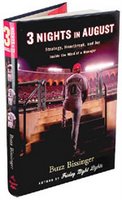 Last week I was in the Denver airport waiting for my flight home and I was faced with an unsettling feeling: I am bookless. There are so many books that I feel I need to read: Freakonomics, The Long Tail, or the one that I thought was at the top of my stack, Small Is the New Big by Seth Godin.
Last week I was in the Denver airport waiting for my flight home and I was faced with an unsettling feeling: I am bookless. There are so many books that I feel I need to read: Freakonomics, The Long Tail, or the one that I thought was at the top of my stack, Small Is the New Big by Seth Godin.
But as I scanned the shelves at the Hudson Booksellers the words of my wife and so many of my colleagues echoed in my head: “If you read another business book next, I’ll kill you.” Sounds threatening but I really do have a problem with this. It’s unintentional. And I’m not trying to brag but I just read these books faster than others. (I must have a problem with fiction in general. Even when not reading business books, I love non-fiction. Sports non-fiction, memoirs, essays, and biographies.)
I was especially antsy that night because it was Game 3 of the World Series and I had to get to the airport sports bar to watch as much as I could before going “silent” on the plane. (I’m a bit of a Cards fan by default — they’re my son’s favorite team. I prefer the more tepid, lukewarm response that I like all Midwestern teams equally.) So it was probably a subliminal thing that led me to purchase 3 Nights in August, Buzz Bissinger’s take on a 2003 three-game series between the Cubs and the Cards told through the transitioned lenses of manager Tony LaRussa.
Well, the Series came out just like I wanted it to and the book appears to be headed that way as well. I’ve also come to the conclusion that 3 Nights in August, is actually what I’m calling a non-business business book. By that I mean seeing the series through Tony’s eyes, you get a feel for the elements of strategic planning and management that go into a game simplistically referred to as “America’s past time.” You see LaRussa pouring over video and statistics but not being totally driven by them. This is important: he straddles the line of intellect and intuition in a way that is applicable to several aspects of day-to-day life in modern baseball and business.
He also posses what Tom Peters calls a “bias for action.” When in doubt, do something. We see LaRussa’s now famous (back then, thought to be crazy) experimenting with the injured Albert Pujols’ position to get him back into the line up as a perfect example of trying something to get results (which he did).
The Point? I’m not saying Transition Tony is Peter Drucker but you might find this read interesting and surprisingly applicable. Plus, if you’re a baseball fan it is a hell of an easier read than Drucker. I think ‘The Point’ is also like Tony pacing around and tinkering with the line up. You have to expose yourself to all kinds of non-linear things to be open to a crazy idea that could be the equivalent of getting Pujols back into your line up.
P.S. You might also enjoy this post by Tom Peters, if for nothing else than his free PowerPoint on Think vs. Do. Enjoy!








